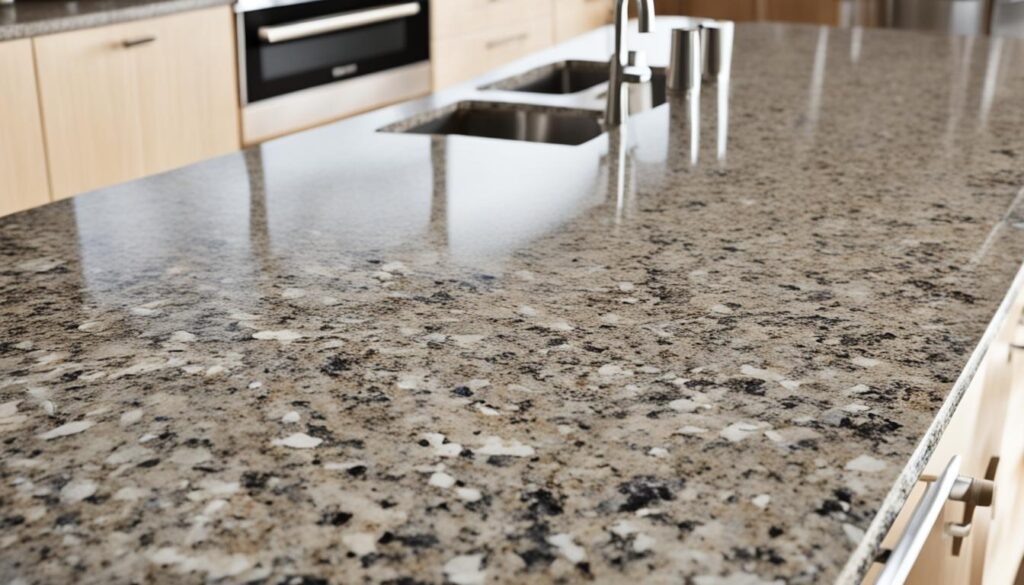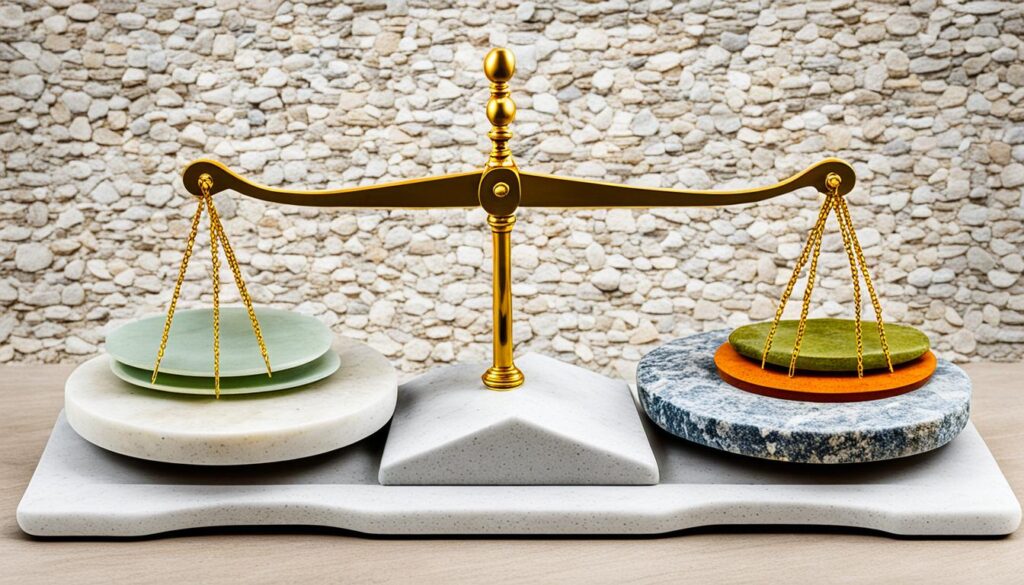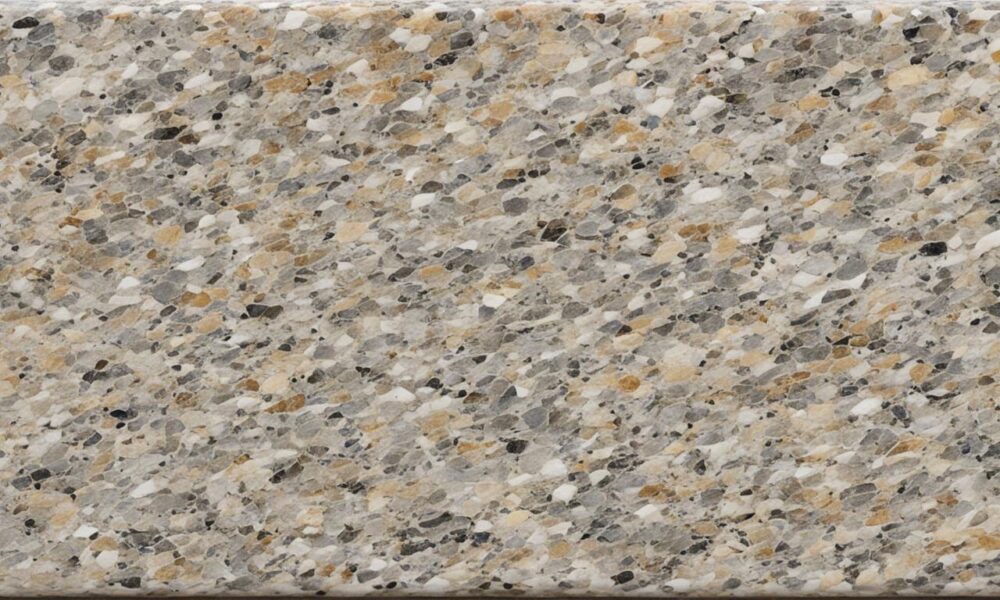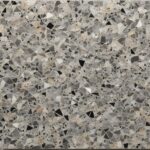Natural Stone Comparison for Your Project Guide
Natural stones are loved for their gorgeous looks, toughness, and flexibility. They are key in many projects, from home updates to huge business sites. Picking the right stone means knowing your project’s needs, like where you’ll use it, what it has to do, and how you want it to look.
There are lots of natural stones to choose from. Some favorites are granite, marble, travertine, slate, and limestone. Each one has its own qualities and is good for different uses. For example, granite is super tough and heat-proof, great for busy kitchen counters. Meanwhile, marble is elegant but needs care; it’s perfect for areas that don’t see a lot of use.
Cost is also important. The price of a stone reflects its rarity, quality, and where it comes from. Knowing this, choosing stones from the same batch can help keep your costs in check. It also means your project will look consistent and beautiful.
Key Takeaways
- Granite offers robustness and heat resistance, ideal for high-traffic areas.
- Marble brings elegance but requires careful maintenance and sealing.
- Travertine’s porous nature and earthy tones suit both indoor and outdoor uses with regular sealing.
- Slate provides a natural, rustic look and is great for flooring and roofing.
- Limestone, best for low-traffic areas, needs frequent care to maintain its appearance.
Understanding Your Project Requirements
Choosing natural stone for your project is vital. Each stone type has unique traits. It’s crucial to match them with your project’s needs, location, and look you want to achieve.
Consider the Location
The spot where you’ll use the stone affects your choice. Granite is great for busy spots like kitchen tops. It’s tough and resists scratches and heat well. On the other hand, marble suits areas like bathrooms, adding elegant beauty. It’s not best for heavy-use spots. Also, think about if the stone is for indoors or outside. This choice helps. Some stones like travertine and slate fit both but have different care needs.
Define the Function
What you’ll use the stone for is important. Each type is good for different jobs. For example, slate is perfect for floors and roofs. It’s slip-resistant, keeping people safe. Travertine can be indoors and outdoors. But, it needs to be sealed often to avoid stains. Knowing the stone’s function helps pick the right one. This way, your project will look good and last long.
Identify Desired Aesthetic
How your stone looks should match your project’s style. Marble adds timeless beauty with its patterns and colors. But, it needs regular care. Limestone’s soft colors bring an elegant, laid-back vibe. It’s great for areas where you want a subtle look. Choose a stone that fits your color and design. This ensures your project’s visual success.
Thinking about the location, function, and look helps choose your stone wisely. This approach ensures your project looks great and stays strong for a long time.
Popular Types of Natural Stone
There are many natural stones to pick from. Each one has its own benefits for different projects. For instance, you might choose based on looks, how long it lasts, or how easy it is to keep up.
It’s important to compare different stones for your project. This way, you can find the best one for what you need.
Granite
Granite is known for its strength and durability. It’s great for places that get a lot of use, like kitchens. It doesn’t scratch easily and can handle hot pans.
But, you need to seal granite often to keep it strong. It comes in many colors and patterns, fitting various styles well.
Marble
Marble gives a room a fancy look with its designs and colors. It makes spaces feel rich and elegant. You often see it in fancier homes and buildings.
Yet, marble can stain and wear down over time. You have to clean and seal it often. Because it’s not super tough, it’s best for places that don’t get a ton of use.
Travertine
If you like natural colors, travertine is a good pick. It works indoors or out, fitting many styles. Just know you need to seal it regularly.
It’s a popular choice because it looks great in all kinds of designs.
Slate
Slate is both tough and pretty. It doesn’t easily break, making it good for many places. Plus, its earthy look adds charm to any room.
Since slate is natural, it’s good for the environment too. But, it can get damaged by too much water. And, it might feel cold when used for flooring.
Limestone
Limestone has a simple and soft look. It’s perfect for places that don’t get used a lot. People like it for its classic feel.
But, limestone can get ruined by acids and water. You have to care for it well to keep it looking nice.
This stone is best if you want a delicate touch in your design.
| Stone Type | Pros | Cons |
|---|---|---|
| Marble | Accessible, variety in colors and veining patterns | Susceptible to staining and etching, requires regular maintenance |
| Granite | Extremely durable, large pattern and color range | Requires regular resealing, can fall out of style |
| Soapstone | Heat resistant, stain-resistant | Limited color choices, can chip or scratch |
| Quartzite | Marble-like appearance, granite-like properties | Prone to scratching, requires regular maintenance |
| Serpentine | Etch resistant, non-porous | Mainly available in one green look, softer than granite |
| Slate | Classic and attractive, resistant to damage | Susceptible to moisture damage, cold for flooring |
| Limestone | Easy to shape, old-world feel | Susceptible to acidity and etching, requires regular maintenance |
Granite: Durability and Versatility
Granite is known for being both tough and versatile. Many people choose it for different uses. It’s good for kitchen countertops and busy areas because it’s strong against scratches and heat. It stays looking good even with a lot of use.

Ideal Applications
There are many colors and patterns in granite. This makes it fit different design styles. It’s commonly used for:
- Kitchen countertops that need to stay looking good.
- Bathrooms where both looks and toughness matter.
- Outdoor areas like patios and pool sides, thanks to its durability.
Maintenance Requirements
Granite is pretty easy to care for compared to other stones. Yet, it’s a good idea to seal it often. This keeps it strong and looking nice over time. Just clean it regularly with mild soap and seal to keep stains and water away. This shows why granite is great for tough jobs that also need to look good.
Comparing Different Types of Natural Stone for Your Next Project
Choosing natural stone for your project means looking at durability, maintenance, how it looks, and the price.
Granite is very tough and not too expensive, perfect for busy spots. It’s in the high-cost range ($$$), but it lasts a long time. Marble looks elegant but is softer and better for showy, low-traffic uses. It costs medium ($$).
Quartzite is strong like granite and costs a lot ($$$), good for tough-use areas. Soapstone is cheaper ($) and durable, good for places that need to be clean, like labs and hospitals.
Onyx is ultra-luxurious but wears down fast. It’s great for quiet areas. Quartz lasts and costs similar to granite and quartzite ($$$). Porcelain is a good deal ($) and strong, perfect for walls in places like the kitchen.
Solid surface materials are the cheapest, costing little ($) but lasting well. They’re good for big projects when you’re watching your budget.
Thinking about these points when picking your natural stone helps you choose well. It keeps your project on track and looking good, balancing use and beauty.
Marble: Elegance and Maintenance
Marble is not just for looks; it brings a touch of luxury and elegance. It’s the go-to for fancy homes and businesses. The stone’s elaborate designs and bright hues create a posh look.
Beautiful Patterns and Colors
Every piece of marble is like a work of art – no duplicates. You’ll find kinds such as Nero Marquina, Sahara Noir, and Arabescato Marble. They all have their own special patterns and colors. For a luxurious touch, Calacatta Oro Marble stands out with its unique veins and golden colors.
Considerations for Use
If you’re going for marble, know it needs a bit more love. It’s not as tough as granite. Marble can stain easily and get marks from acidic stuff. Keeping it sealed and maintaining it well is key to its longevity.
Marble boosts your place’s value and looks gorgeous. But, it’s best in quieter spots like bathrooms or around dining tables. For busy areas like kitchens, choose it for its seamless design and cool touch. Just keep in mind, you’ll need to stay on top of its care.
When picking between marble and other stones, think about the look and effort you’re willing to put in. Working closely with experts and reliable suppliers helps guide you. They can suggest the perfect marble for your project.
Understanding the Characteristics of Travertine
Travertine is a type of limestone known for its unique texture and look. Its rustic beauty is both eye-catching and useful in many places.
Popular Uses
Many people love travertine for its natural look and uses. In Columbus and Cincinnati, it’s a top choice for bathrooms due to being water-resistant. It’s also great for foyers and outdoor areas, adding value with its special veins and designs.
Porous Nature and Care
One key thing about travertine is its porousness, showing a lot of holes. Although this makes it interesting, it means you have to look after it well. Sealing it often is a must to avoid damage and stains, but this maintains its beauty.
Even with the care needed, travertine is still a great pick. It’s tough like other natural stones, fitting well indoors and some outdoor places.
The Rustic Appeal of Slate
Slate has a rustic look that’s perfect for different projects. Its natural texture and colors work well with traditional and modern designs. When you look at stones for projects, you’ll see slate is both beautiful and useful.
Ideal Environments
Slate is great for places that need to look good and work well. It can be used in floors, roofs, and walls outside. What makes slate great is how well it fits different styles, from a country cabin to a city home. This makes designers and homeowners love working with it.
Durability and Safety
Slate is tough and doesn’t easily get damaged. It’s good for places that have a lot of people walking around. Since it’s not slippery, it’s safer to use outside or in wet places. This makes slate a top choice for areas where safety matters a lot.
Even with its durability, slate can get damaged by too much water. Plus, it can feel cold. These points are important to know when choosing stones for a project. But, if you take care of it, slate can look good and work well for many years.
Limestone: Softness and Sophistication
Limestone is loved for its simple beauty and classic look. It’s a top pick for both inside and outside spaces. More people in places like Columbus and Cincinnati are choosing limestone for its flexibility and style. We’ll explore the best uses and care tips for limestone.
Best Applications
Limestone is great for places that don’t get a lot of traffic and for showy spots. It’s often picked for fireplace mantels and bathroom counters because of its elegance. Outdoors, it holds up well against the weather. This makes it perfect for areas around pools and for paving patios.
About 10% of all sedimentary rocks in the world are limestone. This shows just how much of it is out there. There are many types, such as British limestone from places like the Peak District, Turkish limestone full of unique patterns, and Indian limestone with its special finish. It can take a lot of steps without wearing out and keeps cool in hot weather, making it great for parts of the house that see a lot of people.
Maintaining Limestone
As lovely as it looks, limestone needs some extra care to stay beautiful. It has to be sealed often to keep stains and water damage away. Spills should be cleaned up right away, especially if they’re acidic, to avoid harm. Even though its softness adds to its beauty, it can scratch or chip easily. This means it must be handled gently and checked by a pro now and then.
Limestone might cost more at first, but it lasts long and is easy to take care of. When looking at different types of natural stone, it stands out as one that’s good for the planet thanks to how it’s found and its green qualities.
| Limestone Feature | Description |
|---|---|
| Best for | Fireplace surrounds, bathroom vanities, outdoor patios, pool surrounds. |
| Durability | Ideal for high-traffic areas; naturally durable. |
| Maintenance | Regular sealing and prompt cleaning of spills; sensitive to acids. |
| Climate Suitability | Natural cooling effect; ideal for warm climates. |
| Cost | High initial investment but offers long-term value. |
It’s important to know about limestone to make smart choices for your projects. By understanding how it compares to other stones, you can create spaces that are both beautiful and useful.
Budget Considerations When Choosing Natural Stone
Starting a project with natural stone means considering your budget carefully. Choosing the right stone depends on many things. This includes the kind of stone, how easy it is to get, and extra finishes. We’ll look at the costs and tips for picking stone to fit both your look and budget.
Cost of Different Stones
The price of different natural stones is an important part of choosing. Hard and tough granite is a good budget option, suited for places with lots of foot traffic. Marble, which brings elegance, costs more because it’s porous and needs special care. Limestone and sandstone are in the mid-price range. Limestone is often used for its strength in floors and walls.
Stone weight is also key. Heavier stones like granite cost more to move and install. But, granite, being less porous, lasts longer in freezing conditions and needs less care.

Balancing Aesthetics and Budget
Finding the balance between looks and cost is vital when choosing natural stone. Even though natural stone is more expensive, it shows quality and uniqueness. Manufactured stone is cheaper, but it’s not as long-lasting.
The color and pattern of a stone affect its price. Unusual colors and patterns are more expensive. Standard stones save money. Special finishes like honing also add to the cost but look great. Maintenance is important too. Some stones, like marble, need regular care, which adds to the long-term costs.
| Stone Type | Cost Range | Durability | Maintenance | Recommended Uses |
|---|---|---|---|---|
| Granite | Medium | High | Low | Countertops, Flooring, Exterior Applications |
| Marble | High | Medium | High | Bathrooms, Decorative Accents, Low-Traffic Areas |
| Limestone | Medium | Medium | Medium | Flooring, Wall Cladding, Outdoor Paving |
| Slate | Medium | High | Low | Roofing, Flooring, Walkways |
| Sandstone | Medium | High | Low | Patios, Garden Paths, Landscaping |
Conclusion
Choosing the right natural stone for a project involves considering many things. You should look at how it will look, work, and the cost. Think about where it will be used, what it will do, and how it will look. This helps make sure the stone looks good and does well.
Granite, marble, soapstone, and quartzite each have their own benefits. They are good for different uses. This way of thinking helps pick the best stone for your project.
When it comes to countertops, natural stones like granite need sealing over time. But, quartz, which is mostly natural, doesn’t need this. Yet, quartz can get damaged by heat more easily.
Comparing prices, granite and quartz are about the same. Still, you can get affordable granite that is good quality. Choosing carefully means you won’t have to give up quality or looks.
To choose the right natural stone, you must understand a few key points. Considering your budget and the stone’s use is essential. This makes sure your project looks great and lasts. For more help on choosing natural stone, check out Eastern Surfaces. They can guide you in making the best choice that lasts.



